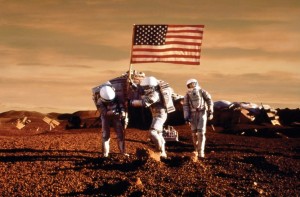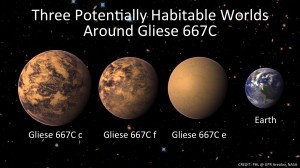Becoming a space faring civilization is the goal of millions of Earthlings. If one pays attention to the universe around him, it is impossible to deny its ability to cause breathtaking humility. We long to explore, to expand, to go out and touch a piece of another planetary body. This longing is what encouraged NASA and their supporters to stand behind the Apollo missions to the Moon. President John F. Kennedy said, “We choose to go to the Moon not because it is easy… but because it is hard.” We need to find that will again. The interest in going out and exploring and settling Mars is obvious. One indication is the fact that when applications for a trip to Mars opened, there were 78,000 applicants to go in just two weeks. Other clues are the sheer number of private organizations that are being created dedicated to human Mars exploration. Inspiration Mars is one example. Its founder, Dennis Tito, believes so wholeheartedly in a humans to Mars mission, that he is funding the first two years of the project himself.
 Some people suggest that we should not go to Mars; we should go to the Moon first. While that may be an option, there are many reasons for sending humans to Mars and not the Moon. Humanity needs a new place to settle, not just plant a flag and go home. We need natural resources in order to make a comfortable and manageable new home for humanity. There needs to be rich soil for growing crops, an atmosphere to protect us from harmful radiation, mineral ore for technology, and water.
Some people suggest that we should not go to Mars; we should go to the Moon first. While that may be an option, there are many reasons for sending humans to Mars and not the Moon. Humanity needs a new place to settle, not just plant a flag and go home. We need natural resources in order to make a comfortable and manageable new home for humanity. There needs to be rich soil for growing crops, an atmosphere to protect us from harmful radiation, mineral ore for technology, and water.
The Moon made big news when it was discovered that there were immense amounts of water in the permanently shaded craters at the North and South poles. It has also been discovered that the rocks of the Moon possess water. However, the water would have to be processed and mined in such a way that it would be an extraordinary expense of energy to process the water into a usable form. However, Mars has water seemingly everywhere we look. The Phoenix Lander landed on top of an ice field covered by a thin layer of Martian regolith. The soil on Mars contains an abundance of water. The polar caps have enormous amounts of H2O. Also, scientists theorize, because of the geological history of Mars and it’s similarities to Earth, it is very likely that there are underground reservoirs of water present.
 The Moon contains carbon, hydrogen, and nitrogen. These are essential elements for survival. However, these elements are found in very small concentrations of parts per million. Oxygen is abundant on the Moon. It is present bound in oxides, such as ferrous oxide and magnesium oxide. In order to utilize the oxygen on the Moon, it must be separated from the tightly bound oxides. This requires excessive amounts of energy to reduce into their separate elements. We have seen that there are vast amounts of H2O on Mars, hence, oxygen is abundant. Separating the water molecule on Mars is far less daunting than separating the oxides on the Moon. Consequently, oxygen will be more readily accessible for future Marsonauts.
The Moon contains carbon, hydrogen, and nitrogen. These are essential elements for survival. However, these elements are found in very small concentrations of parts per million. Oxygen is abundant on the Moon. It is present bound in oxides, such as ferrous oxide and magnesium oxide. In order to utilize the oxygen on the Moon, it must be separated from the tightly bound oxides. This requires excessive amounts of energy to reduce into their separate elements. We have seen that there are vast amounts of H2O on Mars, hence, oxygen is abundant. Separating the water molecule on Mars is far less daunting than separating the oxides on the Moon. Consequently, oxygen will be more readily accessible for future Marsonauts.
As far as energy production is concerned, the Moon does not have an atmosphere so there is no way to produce wind energy. There are no active geothermal hotspots on the Moon, so that power source is out of the question as well. Mars has a thin atmosphere, but it does generate enough wind for turbines to generate power for future Martian settlers. There are geothermal hotspots on Mars that occasionally shoot water up to the surface. We could house geothermal energy production stations at these sites. The Red Planet also possesses enormous supplies of carbon and hydrogen. These elements are used in to manufacture silicon. Solar panels utilize silicon for their photovoltaic cells. As one can see Mars has the potential for a large power base, whereas the Moon has less potential to generate large amounts of energy. Humanity requires a rich power base in order to maintain their vibrant civilization. Mars has that requirement in abundance.
 The regolith on the Moon is deficient in the necessary elements to grow crops. Any crops grown on the Moon would require the rich soil be imported from Earth. Also, the sunlight is more powerful on the Moon, but there is no atmosphere to protect any plants that may be grown there. Very large and thick protective glass would have to be manufactured in order to protect the crops from the harmful radiation from the sun. Another issue with growing crops on the Moon is the 28 day light/dark cycle. Plants on Earth have evolved to a 24 hour light/dark cycle in order to grow and reproduce successfully. The Red Planet has all of the elements necessary to grow crops present in its soil right now. Some scientists report the alkalinity of the Martian soil would be conducive to growing green beans and asparagus. The atmosphere is already thick enough to protect Martian plants from solar flares. Thin-walled greenhouses on Mars would be necessary at first. The ingredients for manufacturing the plastics needed for greenhouses exist on Mars now and could be manufactured quickly once humans have set up the necessary infrastructure. Also, there is a 24 hour and 37 minute light/dark cycle which would be almost exactly what Earth plants have evolved to survive in.
The regolith on the Moon is deficient in the necessary elements to grow crops. Any crops grown on the Moon would require the rich soil be imported from Earth. Also, the sunlight is more powerful on the Moon, but there is no atmosphere to protect any plants that may be grown there. Very large and thick protective glass would have to be manufactured in order to protect the crops from the harmful radiation from the sun. Another issue with growing crops on the Moon is the 28 day light/dark cycle. Plants on Earth have evolved to a 24 hour light/dark cycle in order to grow and reproduce successfully. The Red Planet has all of the elements necessary to grow crops present in its soil right now. Some scientists report the alkalinity of the Martian soil would be conducive to growing green beans and asparagus. The atmosphere is already thick enough to protect Martian plants from solar flares. Thin-walled greenhouses on Mars would be necessary at first. The ingredients for manufacturing the plastics needed for greenhouses exist on Mars now and could be manufactured quickly once humans have set up the necessary infrastructure. Also, there is a 24 hour and 37 minute light/dark cycle which would be almost exactly what Earth plants have evolved to survive in.
 The fact that Mars has so many similarities to Earth is the reason why it is the best candidate for the expansion of the human civilization. The axial tilt is within one-half of a degree, causing seasons. The day is within 37 minutes, having a very similar light/dark cycle to Earth. The temperatures are within the range which is not beyond our technology for tolerability. Once we land and settle on Mars, the next step is terraforming. We will turn Mars into an Earth-like planet, in order to have an enduring civilization present.
The fact that Mars has so many similarities to Earth is the reason why it is the best candidate for the expansion of the human civilization. The axial tilt is within one-half of a degree, causing seasons. The day is within 37 minutes, having a very similar light/dark cycle to Earth. The temperatures are within the range which is not beyond our technology for tolerability. Once we land and settle on Mars, the next step is terraforming. We will turn Mars into an Earth-like planet, in order to have an enduring civilization present.
 On June 25, 2013, it was reported that the extrasolar system named Glieise 667, which is only 22 light years from Earth, has three planets orbiting in its habitable zone. Meaning the temperatures are conducive to the presence of liquid water and possibly life. What does this have to do with the Moon versus Mars? Everything. If we choose wisely, and send humans to Mars, we will be more prepared to be able to send humans to other star systems when the time is right. Mars is the bridge to places like Glieise 667. Humans grow or decay, expand or die. The Mars Society thinks you should live.
On June 25, 2013, it was reported that the extrasolar system named Glieise 667, which is only 22 light years from Earth, has three planets orbiting in its habitable zone. Meaning the temperatures are conducive to the presence of liquid water and possibly life. What does this have to do with the Moon versus Mars? Everything. If we choose wisely, and send humans to Mars, we will be more prepared to be able to send humans to other star systems when the time is right. Mars is the bridge to places like Glieise 667. Humans grow or decay, expand or die. The Mars Society thinks you should live.
~Humans to Mars as a bridge to the stars…..
[Images: NASA, veganshealth, spaceopedia, NatGeo, NASA]